Actions of American aviation against the Japanese islands at the final stage of the war
By early 1945, the 21st Bomber Command was a formidable force capable of simultaneously flying hundreds of B-29 long-range bombers loaded with tons of high-explosive and incendiary bombs.
In the last year of the war, the American command has developed the most effective tactics against Japanese defense enterprises and large cities, and the crews have accumulated the necessary experience and acquired the qualifications that allow them to operate successfully day and night.
Night attacks on Japanese refineries
In addition to the bombing of industrial enterprises with high-explosive bombs and the destruction of residential areas, modified B-29B bombers belonging to the 16th and 501st bombers from the 315th Bomber Wing, with specially trained crews, carried out a series of attacks on Japanese oil refineries and large oil storage facilities ...
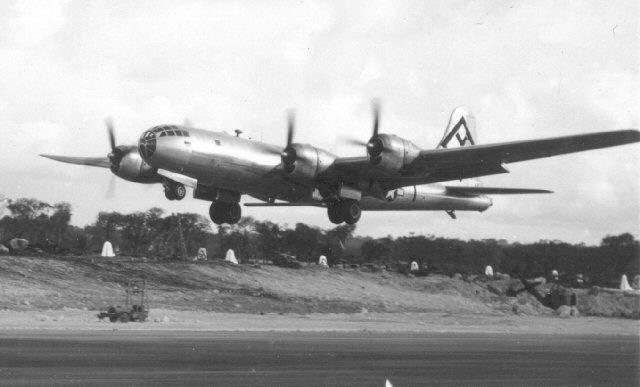
B-29B, equipped with AN / APQ-7 radar, belonging to the 501st bomber group, takes off
The bombing was carried out at night using the AN / APQ-7 sighting and navigation radar. The first night attack involving 30 aircraft at the Yokkaichi refinery took place on the night of June 26. As a result of the bombing, the plant was put out of action, and about 30% of the oil products stored there burned down. The next attack on the Kudamatsu refinery took place on June 29, and on the night of July 2, the Minosima refinery was bombed. On the night of July 6-7, the B-29B, using radars to aim at the target, destroyed an oil refinery near Osaka, and three days later completed the destruction of the Yokkaichi plant. Until the end of hostilities, the crews of the 16th and 501st bomber groups conducted 15 raids on Japanese facilities of the fuel and energy complex. During these attacks, it was possible to completely destroy six of the nine targets attacked, losses amounted to 4 B-29В.
The bombing of small Japanese cities
In order to break the resistance of the Japanese, in the second phase of the "air offensive", simultaneously with the continuation of the bombing of defense enterprises, it was decided to attack 25 relatively small cities with a population of 60000 to 320000 people. Smaller groups of bombers were used to attack small cities than against Tokyo or Osaka.
Before the start of the bombing, the Americans took measures to warn the inhabitants of these cities about the impending attacks. In May-July 1945, the B-29 dropped about 40 million leaflets. The Japanese government imposed harsh penalties on civilians holding such leaflets.
On July 16, 1942, the 21st Bomber Command was transformed into the 20th Air Force, which, together with the 8th Air Force transferred from Europe, and aviation units stationed in Hawaii, became part of the command of the strategic air force in the Pacific.
When the weather was good, during daylight hours, the B-29 navigators-bombardiers, using optical sights, had to bomb industrial enterprises. And in bad weather conditions and at night, strikes were made on residential areas, based on data obtained using on-board radars AN / APQ-13 and AN / APQ-7.
As part of the new plan, five major targeted high-explosive bombings took place: on June 9 and 10, aircraft factories in the vicinity of Shinkamigoto and Atsuta, as well as six defense enterprises on the shores of Tokyo Bay, were attacked. On June 22, attacks were carried out on six targets in southern Honshu, on June 26, factories in Honshu and Shikoku were bombed, and on July 24, Nagoya was bombed.
In parallel with the destruction of the Japanese industrial potential of the Superfortress, groups of 50-120 vehicles were seeded residential areas of small Japanese cities with incendiary bombs. On June 17, B-29 bombers attacked the cities of Omuta, Yokkaichi, Hamamatsu and Kagoshima. On June 19, raids took place on Fukuoka, Shizuoka and Toyohashi. On June 28, Moji, Nobeoku, Okayama and Sasebo were bombed. On July 1, Kumamoto, Kure, Ube, Shimonoseki were bombed. July 3 - Himeji, Kochi, Takamatsu, Tokushima. On July 6, "lighters" rained down on Akashi, Chiba, Kofu, Shimizu. On July 9, Gifu, Sakai, Sendai and Wakayama were attacked. On July 12, B-29s burned down city blocks in Ichinomiya, Tsuruga, Utsunomiya and Uwajima. On July 16, Hiratsuka, Kuwana, Numazu and Oita were bombed. On July 19, houses in Choshi, Fukui, Hitachi and Okazaki were on fire. On July 26, Matsuyama, Tokuyama and Omuta were raided. On July 28, six more cities were attacked - Aomori, Ichinomiya, Tsu, Ise, Ogaki, Uwajima.
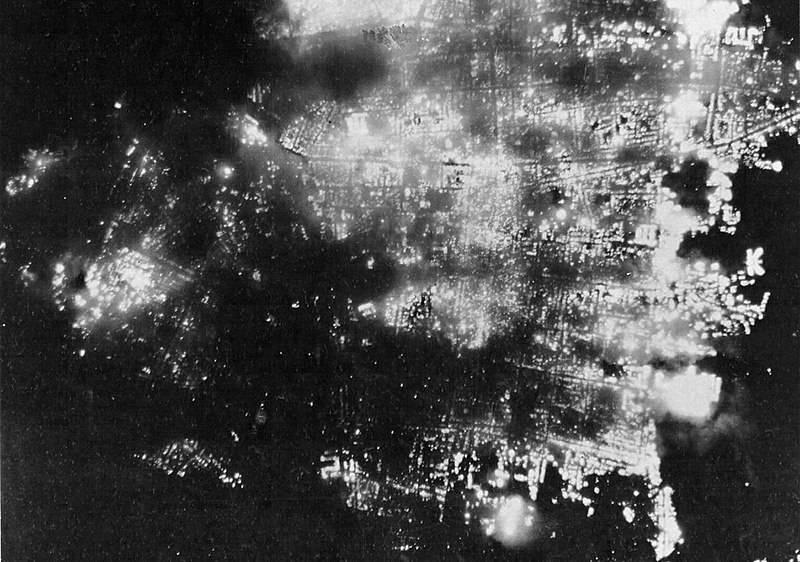
Toyama fires on August 1, 1945
On August 1, the largest raid of the Second World War took place. On that day, 836 B-29s dropped 6145 tons of bombs (mostly incendiary) on the cities of Hachioji, Toyama, Mito and Nagaoka. On August 5, Imabari, Maebashi, Nishinomiya and Saga were attacked. In Toyama, more than 90% of buildings burned down, and in other cities from 15 to 40% of buildings.
In most cases, small towns were not covered by anti-aircraft batteries, and Japanese night fighters were ineffective. During the operation against small towns, only one B-29 was shot down, 78 more returned with damage, and 18 bombers crashed in accidents.
Use of B-29 bombers for mine laying
In mid-1944, American admirals began to demand the involvement of long-range bombers B-29 for laying minefields, in order to block navigation in Japanese waters. General LeMay was not enthusiastic about these plans, but under pressure from the higher command in January 1945, he was forced to allocate the 313rd bomber wing.
The crews of the 313rd Bomber Wing conducted their first mine-laying operation on the night of March 27-28, mining the Shimonoseki Strait to prevent Japanese warships from using this route to attack the US landing force off Okinawa.
As part of Operation Hunger, a joint operation with the US Navy, which aimed to blockade the main ports of Japan and impede the movement of Japanese warships and transports, long-range bombers dropped more than 1529 sea mines with acoustic or magnetic fuses during 12000 sorties. The laying of mines accounted for 5,7% of all sorties made by the aircraft of the 21st Bomber Command.
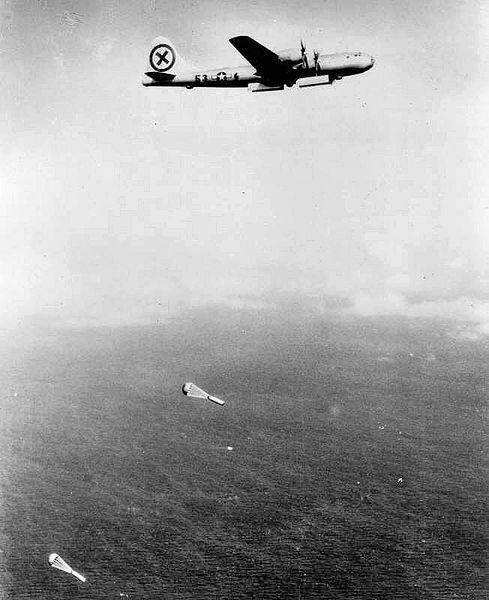
Dropping naval mines from the B-29
Mining was subjected as a way of movement of the Japanese fleetand the largest ports, which seriously disrupted Japanese logistics and the transfer of troops. The Japanese had to abandon 35 of the 47 main convoy routes. For example, shipments through Kobe decreased by 85%, from 320 tons in March to 000 tons in July. Over the past six months of the war, more ships have died on American mines delivered by long-range aircraft than were sunk by submarines, surface ships, and US Navy aircraft. The mines sank or disabled 44 ships with a total displacement of over 000 tons. At the same time, 670 American aircraft were lost.
Strikes by American B-24 and B-25 fighters and bombers against targets in southern Japan
After the P-51D Mustang of the 7th Fighter Command was relocated to Iwo Jima, the leadership of the 21st Bomber Command proposed, in addition to escorting the Super Fortresses, to use fighters to attack Japanese airfields, which was seen as a preventive measure to reduce the combat capability of Japanese interceptors.
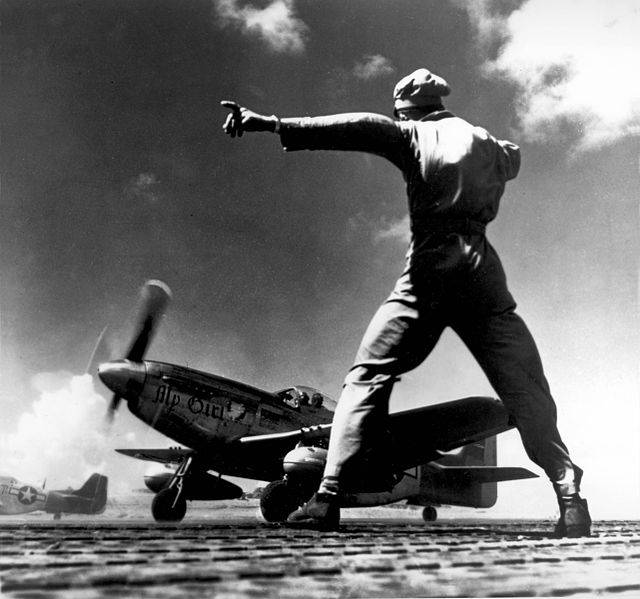
Fighter P-51D Mustang takes off from the airfield at Iwo Jima
In May 1945, aircraft of the American 5th Air Army joined the strikes on the Japanese islands, which included units armed with P-51D Mustang, P-47D Thunderbolt and P-38L Lightning fighters, as well as B-25 Mitchell and B bombers. -24 Liberator.
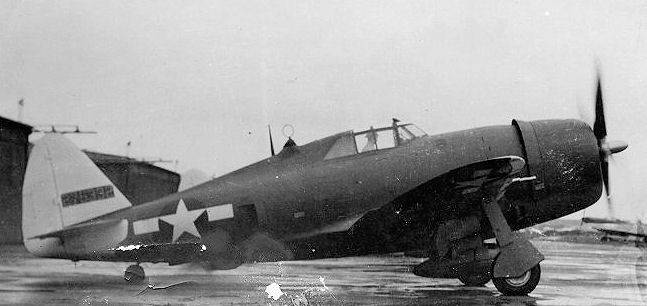
P-47D Thunderbolt 348th Fighter Wing
Fighters and bombers from the 5th Air Force attacked Japanese airfields 138 times. The four-engine V-24 and twin-engine V-25 repeatedly bombed railway junctions, ports, railway and road bridges. From July 1 to July 13, 286 sorties of B-24 and B-25 bombers were carried out from Okinawa against targets in Kyushu.
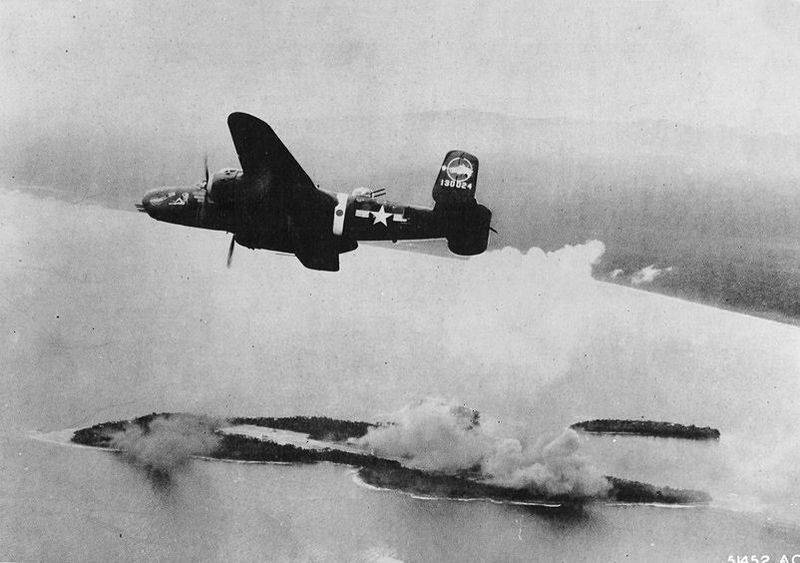
B-25 bomber of the 345th bomber wing
In addition to solving tactical problems, large groups of "Liberators" were involved in strategic bombing. On August 5, "lighters" rained down on the residential areas of Taramizu in Kagoshima. On August 7, an airstrike struck a coal terminal in Umut. On August 10, Kurume was bombed. The last air raids took place on 12 August.
In July and August, fighters and bombers of the 7th Fighter Command and the 5th Air Army flew over 6000 sorties against targets in Kyushu. At the same time, 43 American aircraft were shot down by anti-aircraft guns and Japanese fighters.
Actions of American carrier-based aircraft on targets in the Japanese islands
By the beginning of 1945, Japan was already exhausted and hopelessly lost the initiative in the war at sea. By that time, American aircraft carrier formations had reliable protection against air strikes and were no longer afraid of the Japanese fleet. Task Force TF 58, the main strike force of the US Navy in the Pacific, had 16 aircraft carriers covered by battleships, cruisers and escort destroyers.
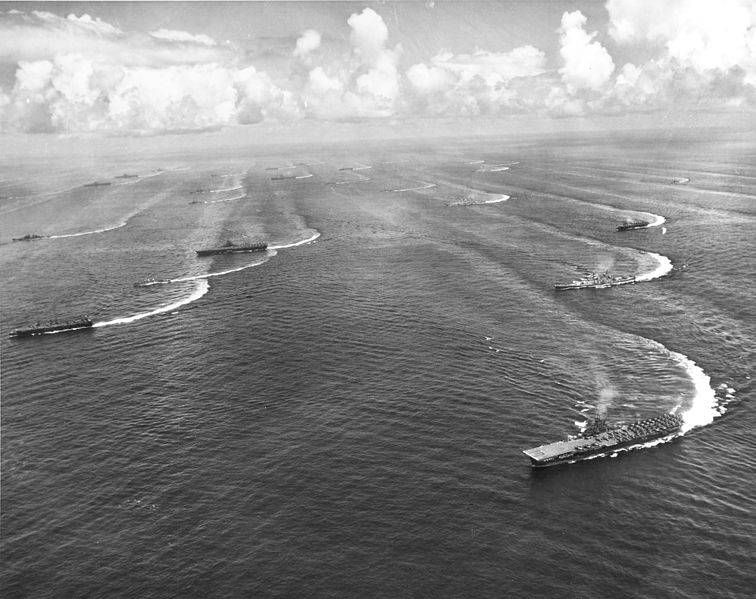
TF 58 ships maneuver in Japanese waters
The first air raids by American carrier-based bombers on airfields and an aircraft factory in the vicinity of Tokyo took place on February 16 and 17. US Navy pilots announced the destruction of 341 Japanese aircraft. The Japanese admitted the loss of 78 fighters in aerial combat, but did not provide data on how many of their aircraft were destroyed on the ground. American carrier-based aircraft in these attacks lost 60 aircraft from enemy fire and 28 in accidents.
On February 18, 1945, ships of the TF 58 formation, without encountering resistance from the Japanese fleet and aviation, went south to support the landing on Iwo Jima. The task force attempted a second raid on the Tokyo area on February 25, but this operation was disrupted due to bad weather, and on March 1, American ships attacked Okinawa.
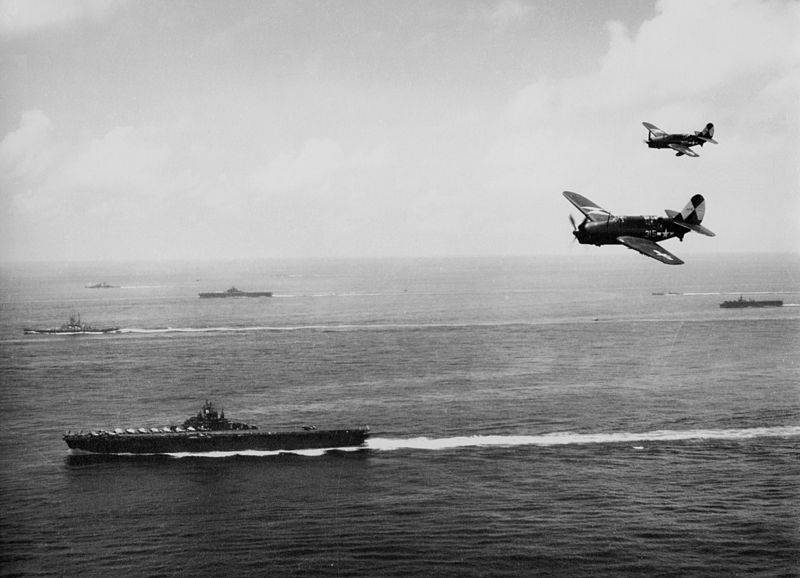
Ships and carrier-based aircraft of the TF 58 compound off Okinawa
The next attack by American carrier-based bombers on Japan took place on March 18. The main targets were Japanese airfields and aviation fuel storage facilities on the island of Kyushu. The next day, carrier-based aircraft bombed Japanese warships in Kure and Kobe, damaging the battleship Yamato and the aircraft carrier Amagi. During attacks on March 18 and 19, American naval aviators said they had destroyed 223 Japanese aircraft in the air and 250 on the ground. While the Japanese estimated their losses: 161 aircraft in the air and 191 - on the ground. On March 23, US Navy carrier-based aircraft destroyed the Japanese coastal fortifications in Okinawa, and on March 28 and 29, they conducted reconnaissance and bombed identified targets in Kyushu.
After the landing of American Marines in Okinawa, carrier-based aircraft provided the isolation of the battlefield and suppressed airfields in southern Japan. In an effort to stop large-scale Japanese air attacks on Allied ships, TF 58 forces attacked kamikaze bases at Kyushu and Shikoku on 12 and 13 May.
On May 27, Admiral William Halsey took over command of the Fifth Fleet from Admiral Raymond A. Spruance. TF 58 was renamed TF 38 (Third Fleet) and continued operations off Okinawa. In late May and early June, one of the task forces attacked airfields in Kyushu. On June 10, the aircraft carriers of the Third Fleet left the area, and the American carrier-based aircraft raids on the southern part of the Japanese islands temporarily stopped.
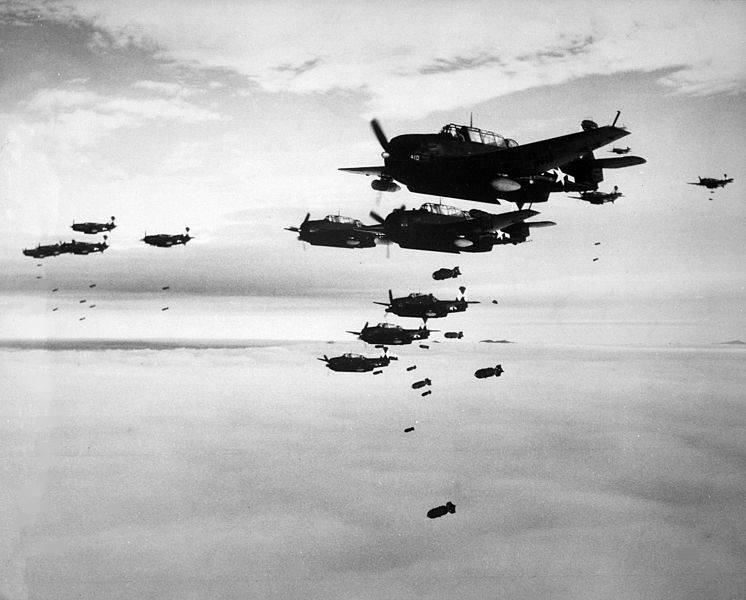
US Navy aircraft TBF Avenger dropping bombs on Hakodate in July 1945
In early July 1945, 15 American aircraft carriers with escort forces again moved to the shores of Japan. On 10 July, TF 38 aircraft raided airfields in the Tokyo area, plowing the runways with mines and destroying several aircraft hangars.
After this raid, TF 38 moved north. And on July 14, an operation began against Japanese transport ships plying between Hokkaido and Honshu. The airstrikes sunk eight of the 12 ferries carrying coal from Hokkaido, and the remaining four were damaged. Also, 70 other ships were sunk. At the same time, not a single Japanese fighter tried to resist the attacks. According to American reports, teams aimed at blocking Japanese airfields on the ground managed to destroy and damage more than 30 aircraft.
The loss of rail ferries reduced the amount of coal shipped from Hokkaido to Honshu by 80%. This caused interruptions in the supply of fuel to Japanese industrial enterprises and greatly reduced the production of military products. This operation is considered the most effective air attack in the Pacific theater of operations against the merchant fleet.
Following the attacks on Hokkaido and northern Honshu, the American carrier force sailed south and was reinforced by the main body of the British Pacific Fleet, which included four more carriers.
The attacks on the industrial zone in the vicinity of Tokyo on July 17 proved to be of little effect due to bad weather. But the next day, fleet aircraft attacked the Yokosuka naval base, where the Japanese battleships were parked. At the same time, one battleship was sunk, and several more were damaged.
On 24, 25 and 28 July, the Allied fleet attacked Kure and sank an aircraft carrier and three battleships, as well as two heavy cruisers, a light cruiser and several other warships. In this operation, the Allies suffered serious losses: 126 aircraft were shot down.
On July 29 and 30, the combined Allied fleet attacked the port of Maizur. Three small warships and 12 merchant ships were sunk. The next attacks on Japan took place on August 9 and 10 and were aimed at the accumulation of Japanese aircraft in northern Honshu, which, according to Allied intelligence, should have been used to conduct a raid on B-29 bases in the Mariana Islands.
Naval aviators said they destroyed 9 aircraft in their attacks on 251 August and damaged 141. On 13 August, TF 38 aircraft again attacked the Tokyo area, after which 254 Japanese aircraft were reported to have been killed on the ground and 18 in the air. The next raid on Tokyo, in which 103 carrier-based aircraft participated, began on the morning of August 15. The second wave was called off halfway when word was received that Japan had agreed to surrender. However, on the same day, aircraft carrier air defense forces on duty shot down several kamikaze who were trying to attack American aircraft carriers.
Atomic bombing of Japan
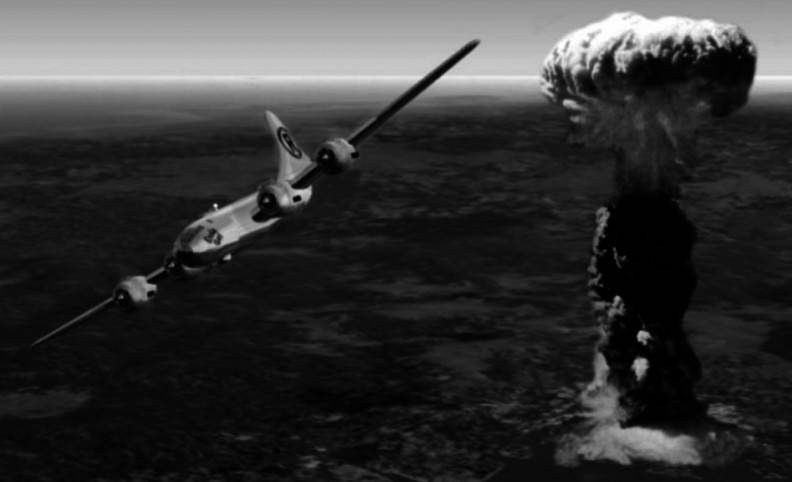
Even before the first nuclear explosive device was tested in the United States, in December 1944, the 509th air group was formed, equipped with specially modified B-29 Silverplate bombers. During World War II, 46 B-29 Silverplate were built in the United States. Of these, 29 were assigned to the 509th air group, and 15 crews took part in atomic bomb training. The deployment of the 509th Air Group on Tinian was completed in June 1945.
On July 20, the B-29 Silverplate began combat training flights to Japan. The combat load of the bombers consisted of one "pumpkin bomb", which in terms of mass and ballistic characteristics imitated the plutonium bomb "Fat Man". Each "pumpkin bomb" 3,25 m long and 152 cm in diameter weighed 5340 kg and contained 2900 kg of high explosives.
Atomic bomb carriers performed combat training missions on July 20, 23, 26 and 29, as well as on August 8 and 14, 1945. A total of 14 bombs were dropped on 49 targets, one bomb was dropped into the ocean, and two bombs were on board aircraft, which interrupted their missions. The bombing technique was the same as during the real atomic bombing. The bombs were dropped from a height of 9 m, after which the plane made a sharp turn and left the target at maximum speed.
On July 24, 1945, President Harry Truman authorized the use of a nuclear weapons against Japan. On July 28, the chief of the joint chiefs of staff, George Marshall, signed the corresponding order. On July 29, General Karl Spaatz, commander of the US Strategic Air Force in the Pacific, ordered the practical implementation of preparations for the atomic bombings. As the main targets for the use of atomic weapons, Kyoto (the largest industrial center), Hiroshima (the center of army warehouses, a military port and the location of the General Staff of the Navy), Yokohama (the center of the military industry), Kokura (the largest military arsenal) and Niigata (military port and heavy engineering center).
Simultaneously with the preparations for nuclear strikes at the Potsdam Conference, the governments of the United States, Great Britain and the USSR developed a joint declaration in which the terms of Japan's surrender were announced. An ultimatum presented to the Japanese leadership on July 26 stated that the country would be devastated if the war continued. The Japanese government rejected the Allied demands on 28 July.
On August 6, at 8:15 am local time, a B-29 Enola Gay aircraft dropped the Malysh uranium bomb on the central part of Hiroshima.
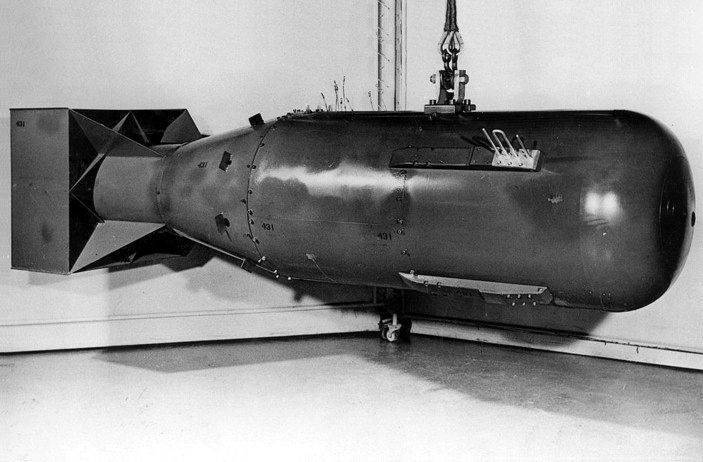
Bomb "Kid"
An explosion with a capacity of up to 18 kt in TNT equivalent occurred at an altitude of about 600 m above the earth's surface at the command of a radio altimeter. The six American aircraft involved in this attack returned safely to the Mariana Islands.
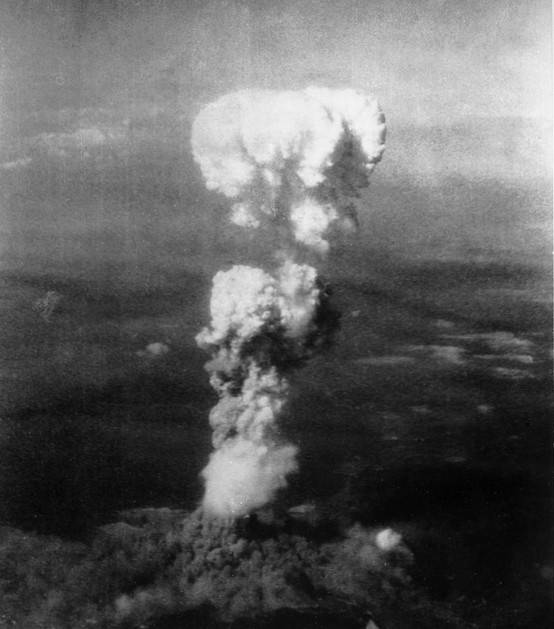
A cloud formed after a nuclear explosion over Hiroshima
Almost all buildings were destroyed as a result of the explosion within a radius of more than 1,5 km. Severe fires broke out on an area of more than 11 km². About 90% of all buildings in the city were destroyed or seriously damaged. However, most of the fires were caused not by light radiation, but by a shock wave. In Japanese homes, food was cooked on coal, in ovens. After the passage of the shock wave, massive fires of dilapidated residential buildings began.
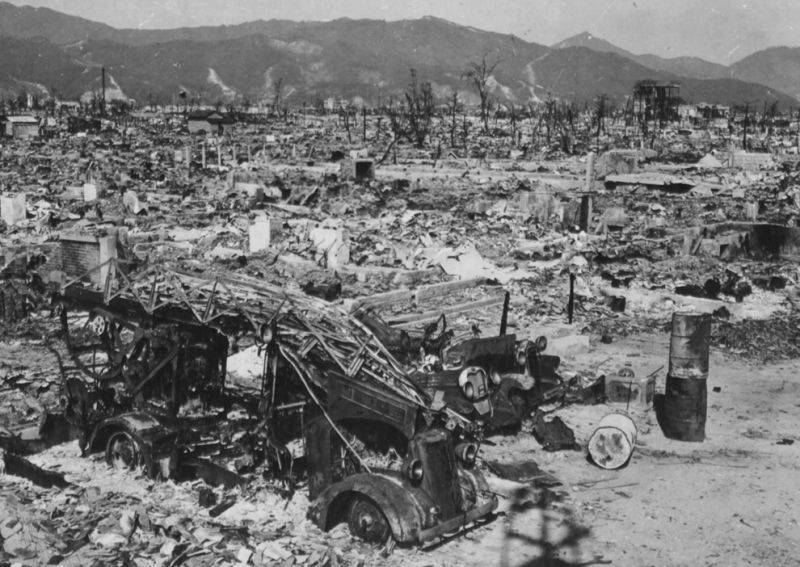
Hiroshima ruins
The atomic bomb is believed to have killed up to 80 people, while about 000 died in the course of the year from injuries, burns and radiation sickness.
The Japanese government did not immediately grasp what had happened. The real understanding of what happened came after a public announcement from Washington. 16 hours after the bombing of Hiroshima, President Truman declared:
However, the Japanese government remained silent and airstrikes on Japanese cities continued.
Two days later, daylight raids with massive incendiary bombs were carried out on the cities of Yawata and Fukuyama. As a result of these attacks, more than 21% of missions were burned in Yawata, and more than 73% of buildings were destroyed in Fukuyamo. Japanese fighters, at the cost of losing 12 of their aircraft, shot down one B-29 and five escort fighters.
The Americans delivered their second nuclear strike on August 9. On that day, a B-29 Bockscar carrying the Fat Man plutonium bomb was sent to attack Kokura. However, the city was covered in haze. As a result, the crew commander decided instead of Kogura to attack Nagasaki, which was a backup target.
The atomic bomb carrier and the escort aircraft were detected by air surveillance posts, but the regional air defense command considered them to be reconnaissance, and the air raid was not announced.
The bomb exploded at 11:02 local time at an altitude of 500 m. The energy output from the explosion of the "Fat Man" was higher than that of the uranium "Kid". The explosion power was within 22 kt. Although the explosion was more powerful than in Hiroshima, the number of deaths and injuries in Nagasaki was less. Affected by the large deviation of the bomb from the aiming point, which exploded over the industrial zone, the terrain, as well as the fact that shortly before that, in anticipation of American air raids, a significant part of the population was evacuated.
The bombing killed approximately 70 people, with another 000 dead by the end of the year. Almost all buildings within a radius of two kilometers were destroyed. Of the 60 buildings in Nagasaki, 000 were completely destroyed and another 52 severely damaged.
On August 9, B-29s dropped 3 million leaflets over Japan warning that atomic bombs will be used against Japanese cities until the Japanese government ends the war. It was a bluff, at that time the United States did not have ready-to-use nuclear weapons, but the Japanese did not know this. Nevertheless, this time there was no response to the ultimatum either.
The Japanese government began negotiations with the allies on the terms of the surrender on August 10. During this period, the B-29 attacks on Japan were limited to the actions of the 315th Bomber Wing against refineries and fuel depots.
The next day, President Truman ordered an end to the bombing in good faith.
However, due to the fact that there was no clear answer from the Japanese, General Karl Spaatz on August 14 received an order to continue raids on Japanese cities. 828 B-29s flew into the air, accompanied by 186 fighters. During the day's raids, high-explosive bombs were struck at the military-industrial complex in Iwakuni, Osaka and Tokoyama, and at night "lighters" rained down on Kumagaya and Isesaki. These were the last attacks by heavy bombers on Japan, as Emperor Hirohito spoke on the radio at noon on August 15, announcing his country's intention to surrender.
The results of the bombing of the Japanese islands and their impact on the course of the war
The actions of the American aircraft caused enormous damage to military and civilian facilities located on the Japanese islands. The Americans dropped over 160 tons of bombs on Japan, with approximately 800 tons of bombs delivered by B-147 bombers. At the same time, about 000% of American bombs fell on Japanese targets six months before the end of the war.
In most cases, the effectiveness of air strikes was high. This was largely due to the fact that at the final stage of the war against Japan, American aircraft operated with very large forces against targets located in a limited area. Japanese cities, where most of the buildings were built from flammable materials, were extremely vulnerable to the massive use of cheap incendiary bombs. At the same time, the crews of American heavy bombers were not required to ensure high bombing accuracy, but only needed to go to the specified area. During the raids, in which several hundred "Superfortresses" could participate at the same time, hundreds of thousands of compact "lighters" fell from the sky, which, scattering over a large area, caused a fire storm over an area of tens of square kilometers.
Massive incendiary bombing of Japanese cities resulted in very significant casualties among the population. Different sources cite different casualty figures, but most of the publications on Japan's losses in World War II cite data from the American post-war report "The Impact of Bombing on Health and Medical Services in Japan." This report states that 333 Japanese were killed and 000 injured. These numbers include approximately 473 killed in the two atomic bomb attacks.
By 1949, the Japanese government estimated that 323 people had been killed as a result of American aviation operations against civilian targets. However, many researchers rightly point out that the Japanese data cannot be reliable, since they relied on preserved archival records. A significant part of the archives was completely destroyed along with the buildings where they were stored. A number of historians in their studies argue that the consequences of the American bombing could have killed up to 495 thousand people.
The bombing caused significant damage to Japanese housing stock. In 66 cities that were subjected to air attacks, about 40% of buildings were seriously damaged or destroyed. This amounted to approximately 2,5 million residential and office buildings, leaving 8,5 million people homeless.
The raids of American bombers also had a huge impact on the decline in the production of military and dual-use products. During the bombing, more than 600 large industrial enterprises were destroyed. The transport infrastructure and facilities of the fuel and energy complex were badly damaged. When American aircraft approached, all enterprises in the area where the air raid was announced stopped working, which negatively affected production.
In fact, the strategic bombing of the B-29 put Japan on the brink of defeat. Even without the use of atomic bombs, hundreds of "Super Fortresses" involved in one raid were able to wipe out Japanese cities.
During the campaign against Japan, the 20th Air Force lost 414 B-29s and more than 2600 American bombers were killed. The financial resources spent on the "air offensive" against Japan amounted to $ 4 billion, which was much less than the expenditure ($ 30 billion) for bomber operations in Europe.
Statistical data processed by American specialists in the post-war period showed a direct relationship between the number of B-29 sorties and the decrease in production volumes by Japanese enterprises, as well as the ability of the Japanese armed forces to conduct hostilities.
But air strikes on residential areas, factories and factories were not the only reason for the decline in the Japanese economy. The work of Japanese enterprises was severely affected by the lack of resources and fuel caused by the mining of shipping lanes and strikes on ports. In addition to large-scale bombing raids, American and British naval aviation disrupted coastal Japanese shipping. The Allied air campaign and attacks on merchant ships destroyed 25 to 30% of Japan's national wealth.
The evacuation of a significant part of the population to the countryside has partially reduced the losses from the bombing. But in early 1945, incessant bombing of ports and heavy losses of the merchant fleet made it impossible to transport food, which, combined with a poor rice harvest in many areas, caused food shortages. There was also a widespread shortage of liquid and solid fuels.
If the war continued, then at the end of 1945, if the current situation persisted, the Japanese population would begin to die of hunger. At the same time, the significant ground forces of the Japanese troops, available in Korea and China, could in no way influence the course of the war, since they themselves experienced significant difficulties in supply.
Assessing the moral aspect of the bombing of Japanese cities, we can confidently assert that the Japanese themselves opened the "Pandora's box". The Japanese military committed numerous atrocities in the occupied territories. And often, American prisoners of war were treated extremely cruelly. You can also remember the brutal bombing of the city of Chongqing, which since 1937 has been the temporary capital of the Republic of China. Given all this, the Americans had the moral right to apply their own methods to the Japanese.
After Japan's surrender, General LeMay said:
In general, this approach can be considered fair.
The strategic bombing, along with the declaration of war by the Soviet Union, made further resistance to Japan impossible. Otherwise, during the invasion of the Japanese islands, the losses of the Americans in manpower could be very significant.
To be continued ...
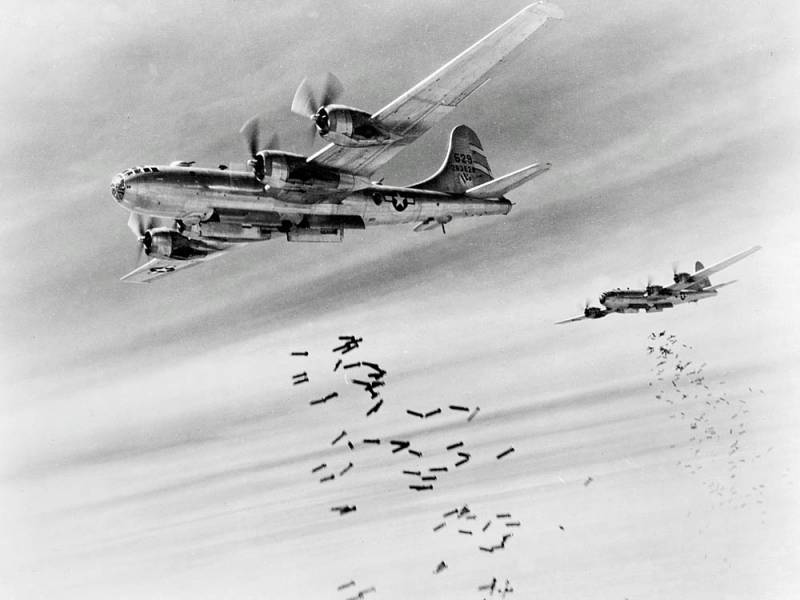
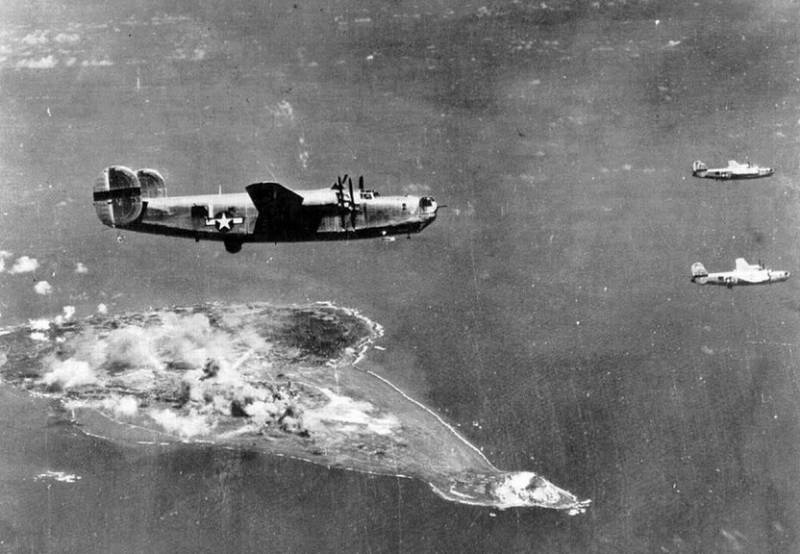
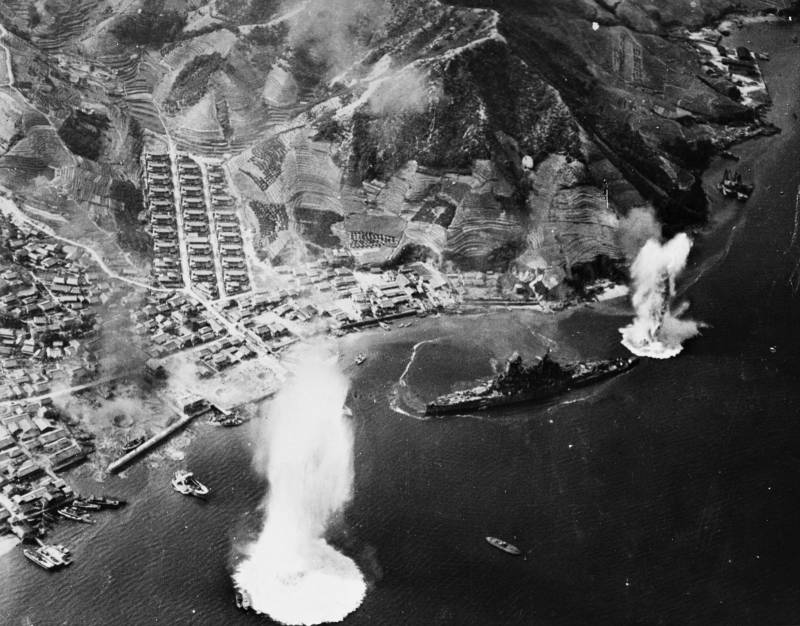
Information